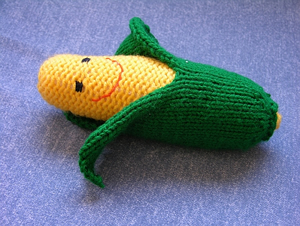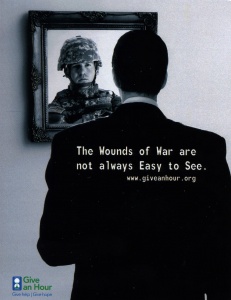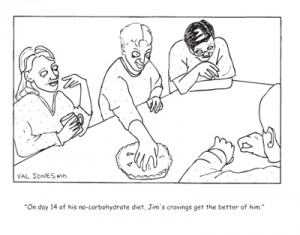Latest Posts
Kerri Morrone-Sparling On dLife, Her Blog, And World Diabetes Day
 |
|
Kerri Morrone-Sparling |
Kerri Morrone-Sparling is a whirlwind of energy. Not only is she the founder of one of the first diabetes blogs on the Internet: SixUntilMe, but she has devoted her career to helping others with diabetes. She works full time at dLife.com, a delightful and practical diabetes website and community. Kerri recently offered me some Halloween survival tips for people with diabetes, and today I had the chance to interview her about her life, her work, and the meaning of World Diabetes Day.
I’ve summarized some of our talking points below for those who don’t wish to listen to the dulcet tones of two very friendly ladies dishing about diabetes.
Dr. Val: Tell me a little bit about your blog.
Kerri: My blog is called SixUntilMe and I started it in May of 2005. I was looking for other people like me who were living with diabetes and since I couldn’t find a community like that I decided to start one myself. As it turns out I wasn’t the only one – there were 2 or 3 other diabetes bloggers out there at the time, and now there are more than 250 of us.
Dr. Val: What does “six until me” mean?
Kerri: My diabetes started when I was six years old – I had a viral illness on my birthday which probably triggered an autoimmune response, causing the disease. My blog is about my diabetes – which started when I was six and is ongoing until now. So I called it “sixuntilme.”
Dr. Val: How are you involved in diabetes advocacy?
Kerri: I work for a diabetes media company, (dLife in Westport, Connecticut) so my entire day is built around reaching out to people with diabetes, trying to make a difference in their life, and connecting them with up-to-date health information. Since I grew up without knowing any other kids who had diabetes, this job is like the holy land. I mean, this whole company was built to help people like me.
Dr. Val: What are some of the worst diabetes myths and what do you have to say about them?
Kerri: First of all, most people don’t know the difference between type 1 and type 2 diabetes, and to make matters worse, they believe that people “give themselves diabetes” by eating too much sugar. So they make it seem like it’s all our fault. Secondly, people often believe that insulin is the cure for diabetes. They don’t realize that a glucose meter, an insulin pump, or a continuous glucose monitor are just technology, not a cure. Sometimes people think there’s no need to donate to diabetes research anymore because these technologies are available. And finally, Halle Berry has promoted a myth that has done a lot of harm to the diabetes community. She claimed that she was able to wean herself off her insulin, and that other type 1 diabetics could do the same if they tried hard enough. Of course, that’s blatantly false.
Dr. Val: What’s your favorite new technology for diabetes management?
Kerri: My continuous glucose monitor (CGM). It doesn’t replace finger stick checks, but it helps you to see the trends in your blood sugar. For example, when you’re about to go to bed and you see that your glucose is 90, the CGM will give you some idea if that’s 90 on its way up, or 90 falling towards hypoglycemia, or 90 holding steady – you can go to bed and not worry about a thing. It’s like swinging on a trapeze only now I have a net.
Dr. Val: How does the machine work?
Kerri: It’s a small device that has a needle in it, and you stick it to a fleshier part of your body. There’s a small wire (introduced through the needle) that continuously samples the sugar level in your interstitial fluid. It’s easy to remove and should be rotated every 3-7 days.
Dr. Val: Is it painful?
Kerri: No, I don’t think so. I use the Dexcom Seven CGM. Occasionally I feel a little prick when I insert it but then I don’t even notice that I’m wearing it. Here’s a photo of me wearing it:
Dr. Val: Tell me about World Diabetes Day.
Kerri: It’s a global awareness campaign that was started in 1991 by the International Diabetes Federation. The United Nations recognized the event for the first time in 2007. It’s a day that directs the world’s attention to diabetes and the epidemic its become and the effort it takes to manage it. On World Diabetes Day bloggers want to spread the word that diabetes is not an invisible disease. It affects lives every day, and it deserves the world’s attention.
Dr. Val: What’s the most important thing for Americans to know about diabetes?
Kerri: They need to know that diabetes is not cured by insulin, and it’s not going away without their help. It’s a very difficult disease to manage. No matter how well you control your sugar levels, the effects of the disease take their toll eventually, and the effects can be devastating. We must not ease up on our research efforts, especially when the numbers of people living with diabetes are growing exponentially.
References
www.diabeticfeed.com
http://the-bad-blog.blogspot.com/
http://www.diabetesdaily.com/johnson/
Kerri writes a column at dLife called Generation D (www.dlife.com/generation_d) and maintains a pretty extensive Flickr account at http://www.flickr.com/photos/sixuntilme/. And lastly, if you’d like to follow Kerri on Twitter, you can find her at www.twitter.com/sixuntilme.
Nutrition Update: Misconceptions, “Magical” Foods, And The Merits Of Fish
 |
Penny Kris-Etherton, Ph.D., R.D., Distinguished Professor of Nutrition (Department of Nutritional Sciences, Penn State University) about what she learned at the American Dietetic Association Food & Nutrition Conference & Expo in Chicago.
Please listen to the podcast here: [audio:http://blog.getbetterhealth.com/wp-content/uploads/2008/11/pennykrisetherton.mp3]
Penny’s take home messages:
1. Corn is not evil. The vegetable itself can be quite nutritious, though high fructose corn syrup is an empty calorie food additive.
2. There is no magic food that will melt your fat away.
3. There is no magic pill that will help you lose weight. You must decrease your calorie intake and increase your exercise.
4. Increasing protein a little bit can increase satiety.
5. Omega-3 fatty acids and iron can improve brain health.
6. Regular fatty fish consumption can reduce the risk of heart disease (2 servings/week).
7. Food first – try to get all your nutrients from the foods you consume. Consider vitamins and supplements only after you’ve been unable to get your dietary needs met from food.
8. Fish oil supplements are safe and pure. There are differences in the amount of omega-3 fatty acids that the supplements deliver, so read the label carefully.
9. A healthy diet is about eating a broad range of nutritious food (don’t scrimp on your veggies), it’s not about supplementing a poor diet with some supplements.
10. Accurate nutrition information is really important. Two trusted sources are: MyPyramid.gov and the American Heart Association
Is Corn Syrup Evil?
 |
Several people have asked me if corn syrup is the root of all evil. This cheap, high calorie sweetener is adding hidden calories to everything from spaghetti sauce to condiments to peanut butter. But is it actually worse for you than “regular” cane sugar? Is there something special about corn syrup that makes it worthy of national vilification?
The truth is that corn syrup isn’t any “worse” than any other highly refined sugar – there’s nothing special about corn that makes it harmful to consume (unless maybe if you’re allergic to corn, but that’s another story). The real issue is that we humans love sweet things, and that food product manufacturers are simply adding sweetener to their products to cater to our taste buds. In so doing, hidden calories add up… and waist lines expand in response.
Folks with diabetes understand how difficult it is to find unsweetened products these days, and they have to work extra hard to avoid the high fructose corn syrup in so many foods. For those of us who don’t have diabetes (yet?) we’d probably do well to follow their example and consciously cut down on our sugar intake if not to manage our insulin levels, but at least to avoid unnecessary calorie consumption.
I myself am a bit of a sugar addict by nature – I resolved to cut down on carbs a few months ago and have dropped 10 pounds already. I have learned to like unsweetened almond milk, unsweetened organic ketchup, and I make my own sauces and avoid refined flour products.
In my next post I’ll speak with Penny M. Kris-Etherton, Ph.D., R.D., Distinguished Professor of Nutrition, Penn State University about what she learned at the recent American Dietetic Association Food & Nutrition Conference & Expo (FNCE) in Chicago. She’ll explain why all the fear mongering about corn is a bit exaggerated.
The Wounds Of War Are Not Always Easy To See
“My daddy’s in Iraq, but he’s not dead yet.”
— 5-year-old son of a US Marine
 |
Roughly 1.7 million Americans have been deployed to Iraq so far. An estimated 320,000 US military have received a traumatic brain injury in the Iraq war. Another 300,000 suffer from major depression or post traumatic stress disorder. The VA is not equipped to handle the mental health needs of all returning veterans and their families. What can we do?
The Give An Hour organization has challenged mental health professionals to donate 1 hour of their time/week to serve the needs of the military. If only 1 in 10 providers joined the program, there would be enough hours to cover the unmet needs.
I met with Dr. Barbara Romberg today to discuss her plans for the program. She envisions an in-office, phone, and online platform for Give An Hour. I sure hope that I can help out with the online platform one day.
If you’re a mental health professional, please consider joining the Give An Hour initiative. Our troops risked their lives for us, and others have sustained life-long injuries – some visible, some invisible.
And there are little boys out there, wondering if this is the day their daddy will die.
Let’s consider how we can be of comfort to those who are suffering on this Veterans Day.












